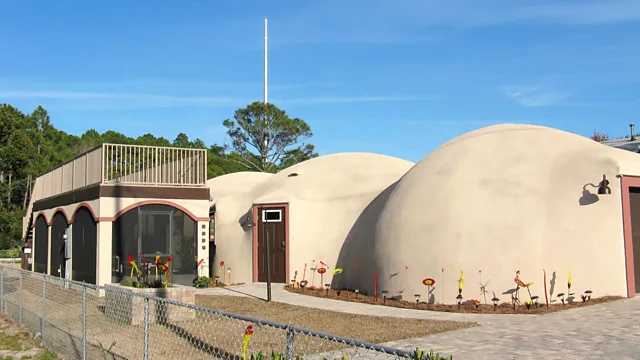Dome Homes In Florida: Surviving Category 5 Hurricanes.
In the face of increasingly destructive hurricanes, some homes in Florida are proving to be resilient against the extreme forces of nature. These dome-shaped houses have weathered even the most catastrophic storms, emerging largely unscathed.
In 2018, Hurricane Michael, a Category 5 storm, struck the Florida Panhandle, becoming the first of its kind to make landfall in the region. The storm wreaked havoc, destroying thousands of homes and structures. Yet, amid the devastation in Mexico Beach, one unique home stood firm against the 160mph (260km/h) winds: “Golden Eye,” a dome-shaped house designed by Margaret Clayton and built by Monolithic Domes in 2015. While Clayton’s neighbours’ homes were reduced to rubble, her unusual structure remained virtually untouched.
Fast forward to 2024, and hurricanes Helene and Milton have once again highlighted the fragility of conventional homes in Florida. Milton, a particularly powerful storm, caused widespread destruction, but homes like Clayton’s are demonstrating that innovative design can offer a vital lifeline in the face of extreme weather.
Experts like Landolf Rhode-Barbarigos, an assistant professor at the University of Miami, have praised the resilience of dome-shaped homes, pointing out how their design helps them withstand high winds. Unlike traditional houses with sharp corners and flat roofs that obstruct the wind, dome homes allow air to flow smoothly around them, reducing the force exerted by the wind.
Deltec Homes, a company with a long history of building hurricane-resistant structures, has constructed over 5,500 domed and rounded homes across the US. According to Deltec, only one of these homes has ever sustained damage from high winds, even after enduring hurricanes such as Irma, Katrina, and the recent Milton. This track record is prompting increased demand for such resilient structures, as people seek more robust defences against the growing intensity of storms.

Steve Linton, President of Deltec, emphasised that building hurricane-resistant homes requires careful engineering and design. He likened the challenge to turning a school bus into a race car, explaining that traditional homes reinforced to resist hurricanes are fundamentally different from those designed specifically with resilience in mind. He also highlighted the aerodynamic benefits of round homes, which can absorb and distribute wind energy more efficiently.
Monolithic Domes, another pioneer in resilient architecture, constructs its homes using concrete and steel, offering even more durability. Their structures can be found around the world, from the Arctic to tropical regions, and are renowned for their energy efficiency and low maintenance costs. Despite these advantages, securing financing for these unconventional homes can be a challenge, as banks are often hesitant to provide mortgages for non-traditional designs.
As climate change intensifies and hurricanes become more frequent and severe, experts believe that resilient architecture will play a crucial role in protecting lives and property. Whether built by Deltec or Monolithic Domes, these homes are offering a glimpse into the future of storm-proof housing. As Linton aptly put it, “You need resilient homes to adapt to the changing world we find ourselves in.”
BBC.



